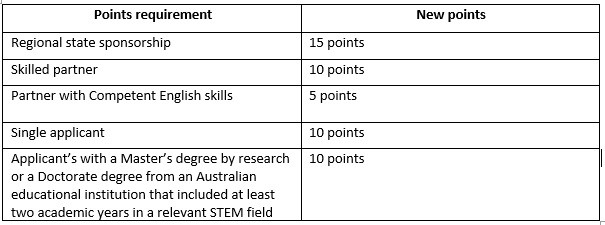The Australian Government has announced significant changes to the General Skilled Migration and Employer Sponsored visa programs for the 2019/2020 program year. The Department of Home Affairs has re-balanced the program to prioritise migrants willing to move to regional Australia, under the new regional visas.
New regional visas to Australia
This shift in focus will see both the Regional Sponsored Migration Scheme (subclass 187) Visa and the Skilled Regional (Provisional) subclass 489 Visa being replaced by two new regional focused visas, both with pathways to permanent residency after 3 years.
The two new visas are:
1. The Skilled Work Regional (Provisional) (SWR) visa or subclass 491 Visa (491 visa); and
2. The Skilled Employer Sponsored Regional (Provisional) (SESR) visa or subclass 494 Visa (494 visa).
There will be 14,000 places available for the 491 visa, and 9,000 places available for the 494 visa, which will be focused on promoting migration to designated regional areas in Australia.
This will result in a reduction in the number of places available under the current subclass 189 visa and subclass 190 visa.
What does this mean for future onshore and offshore migrants? See our frequently asked questions guide below for more information:
FAQs about the new regional visas to Australia:
When will the new regional visas be introduced?
The two new regional visas will be introduced from 16 November 2019.
The new Permanent Residence subclass 191 visa (191 visa) will come into effect from 16 November 2022.
Is the Skilled Migration Points Test changing in November 2019?
New points are being added to the General Skilled Migration Points Test from 16 November 2019.
The new points system provides additional benefits to a number of applicants including: regional applicants, applicants with a skilled partner, applicants with an English speaker partner and single applicants. Here are the new points allocations:

What is a designated regional area of Australia?
From November 2019 the definition of Regional will be replaced by a new and simplified definition.
The new definition states that ‘Regional’ includes all areas of Australia except:
• Brisbane and Gold Coast;
• Melbourne;
• Perth; and
• Sydney.
SKILLED REGIONAL VISA
When does the subclass 489 visa end?
The Government has announced that EOI applications for the subclass 489 visa will close on 10 September 2019, which is also the deadline for states to issue any invitations for the visa.
If you are invited to apply for the subclass 489 visa by 10 September 2019, you must lodge your visa application by 16 November 2019.
What is the new regional subclass 491 visa and how is it different to the subclass 489 visa?
The 491 visa, is aimed at encouraging skilled migrants to reside and work in designated regional areas of Australia.
To encourage migrants to settle in regional areas, the Department of Home Affairs has provided a number of incentives to applicants for the new 491 visa, including:
• Access to 15 points for regional nomination, as opposed to 10 points; and
• Access to priority processing.
The major differences between the new 491 visa and the old 489 visa include:
• The visa grant period will be 5 years, with an opportunity to apply for permanent residency under the new 191 visa after three years. This is a change from the original two years required under the 489 visa;
• The obligation to reside in a regional area now extends to all members of the family unit included in the application. The applicant and all family members need to live, work and study in a designated regional area.
• The applicants may be called for an interview to provide evidence to show they have been living, working or studying in a regional area for the full three-year period.
How can I apply for the new regional 491 visa?
If you meet the eligibility criteria for the 491 visa, you can then follow these steps:
Step 1: Lodge an Expression of Interest (EOI) through SkillSelect
Step 2: Apply for State or Territory Nomination, or be sponsored by an eligible family member living in a designated regional area in Australia
Step 3: Wait for State/Territory approval (if applying under this stream), and then wait for a visa invitation
Step 4: Apply for the 491 visa within 60 days of receiving your visa invitation. Rostron Carlyle Rojas Lawyers can assist you in determining your eligibility for the new 491 visa.
REGIONAL EMPLOYER SPONSORED VISA
When does the Regional Sponsored Migration Scheme (RSMS) (subclass 187) Visa end?
The RSMS Visa (subclass 187) Direct Entry stream will end on 15 November 2019.
The RSMS Visa (subclass 187) Temporary Residence Transition stream will continue to remain open for:
• Subclass 457 visa holders, who held or applied for their 457 visa on or before 18 April 2017; and
• Subclass 482 TSS visa holders, who held or applied for their TSS visa on or before 20 March 2019.
What is the new regional subclass 494 visa?
The new 494 visa, is aimed at encouraging migrants to commit to working and residing in designated regional areas in Australia.
The 494 visa is a regional employer sponsored visa that will involve three stages including: 1) Sponsorship; 2) Nomination; and 3) Visa application. Current Standard Business Sponsors under the TSS visa program will be given the opportunity to nominate 494 visa applicants right away and will not need to undertake the Sponsorship process.
Nominators should be aware that they must make a contribution to the Skilling Australians Fund (SAF Levy) of either $3,000 for a small business or $5,000 for larger businesses.
How can I apply for the new subclass 494 visa?
If you meet the eligibility criteria for the 494 visa, you can then follow these steps:
Step 1 – Sponsorship:
The regional business will need to apply to be a Standard Business Sponsor before nominating applicants under the new 494 visa.
Step 2 -Nomination
If you are considering nominating an applicant for the 494 visa, you must meet the following nomination requirements:
• The position must be located in a designated regional area of Australia;
• The occupation must be on the relevant occupation list or the Labour Agreement;
• The position must be genuine;
• You must undertake Labour Market Testing (no International Trade Obligation exemptions are available);
• You must meet the Annual Market Salary Rate requirements;
• The position must be full-time;
• You will require approval from the Regional Certifying Body (RCB) regarding the market salary of the position; and
• The employment conditions must not be less favourable than those of an Australian worker.
Step 3 -Visa application:
As for 494 visa applicants, you must:
• Be under 45 years of age at time of application;
• Hold a substantive visa or Bridging Visa A, B or C at time of application if applying onshore;
• Hold a successful skills assessment at time of application;
• Have a genuine intention to perform the occupation;
• Have at least three years full-time relevant work experience in the nominated occupation or a related field at the same level of skill;
• Have Competent English skills at the time of application; and
• Meet the health and character requirements of the visa.
How is the subclass 494 visa different to the subclass 187 Visa?
The major differences between the new 494 visa and the old RSMS (subclass 187) visa are:
• There is now a sponsorship process which will need to be undertaken prior to nomination;
• The RSMS visa was a permanent visa, while the new 494 visa is a provisional 5-year visa leading to permanent residency;
• Visa applicants will need to hold a successful skills assessment in their nominated occupation;
• If you wish to change employers during the 5-year period, you will need to be re-nominated by your new employer. If your position changes, you will need to obtain a new skills assessment.
PERMANENT RESIDENCY VISA
What is the Permanent Residence (Skilled Regional) subclass 191 visa and how can I apply for it?
The 191 visa has been established for subclass 491 and 494 visa holders as a pathway to permanent residency.
The visa will come in effect on 16 November 2022.
At time of application, eligible visa holders will need to prove the following:
• The primary applicant has held a regional provisional visa for at least 3 years;
• The primary applicant must have earned a minimum taxable income for the relevant three-year period (this income level is yet to be determined by the Department of Home Affairs);
• The applicants must have complied with the conditions of the regional provisional visa, particularly the requirement to live, work and study in a designated regional area of Australia.
Further details are yet to be released about the November 2019 changes to the Migration Program. The changes are very new and complex and applicants may require professional assistance to navigate them. Rostron Carlyle Rojas Lawyers Migration team is here to assist you to navigate these new visa changes.
Shanalee Johal, Lawyer, MARN: 1910236
To set up an initial consultation with us, please contact Shanalee Johal (MARN 1910236) at [email protected] or 07 3009 8412.



